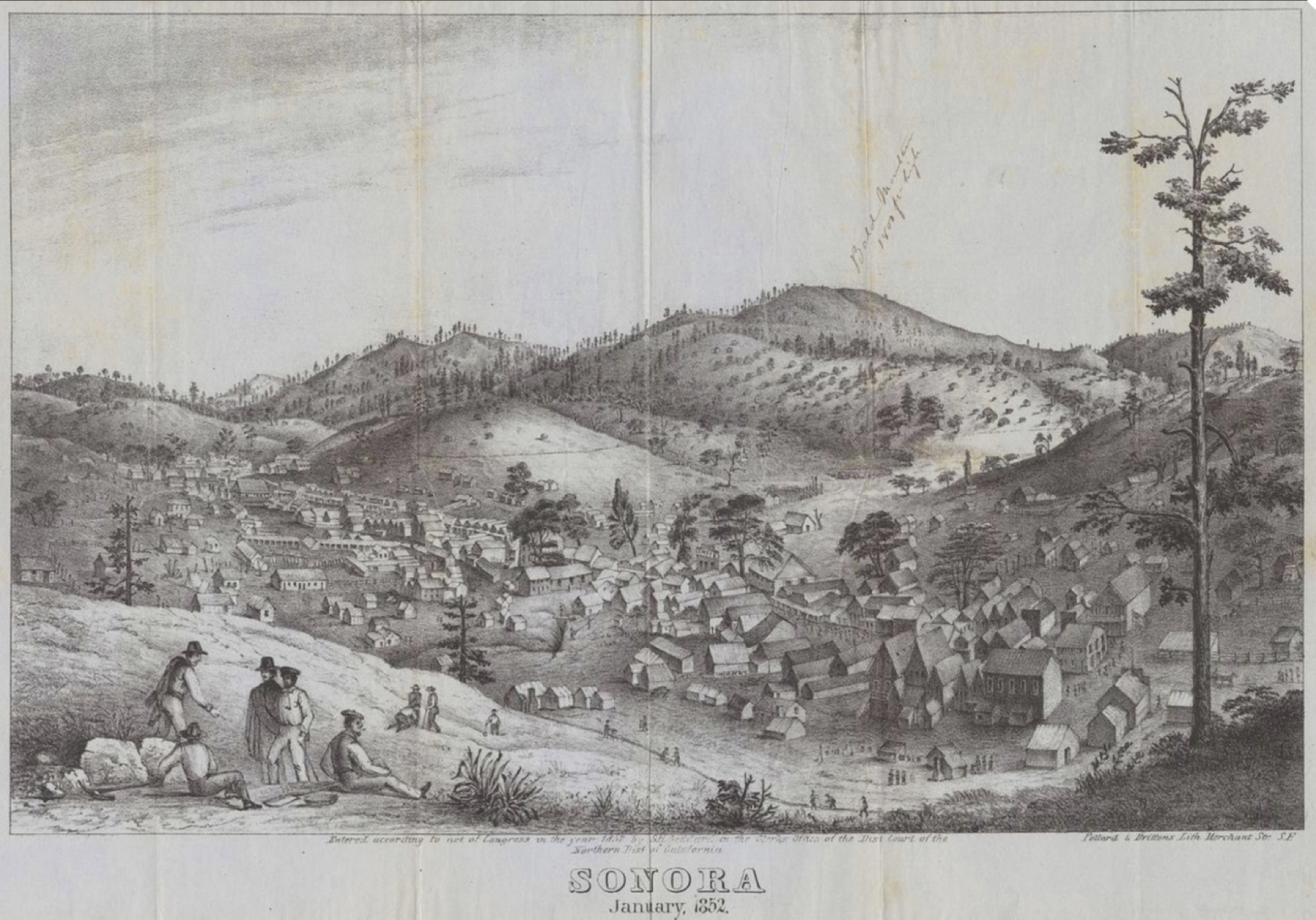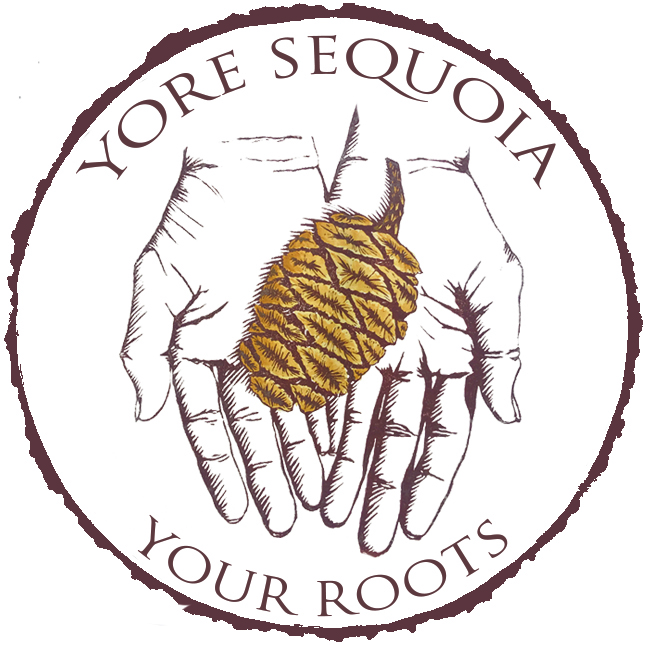Part Three: The Ghost
By Laile Di Silvestro. Published March 2025.
This is Part Three of a multi-part series by historical archaeologist Laile Di Silvestro. The series started with an astonishingly bold act—two women staking a claim in the remote Mineral King Mining District in what is now Sequoia National Park. The tale unfolds in California in the second half of the 19th century. It was place and time where women struggled to thrive within power structures that favored unscrupulous men. It is a true story. Read Part Two HERE.
Our Ellen Gilkey gave birth to Elizabeth Amy on July 19, sometime between 1857 and 1860 in the gold country of Tuolumne County.* By all accounts, Lizzie emerged in a place and time when drunken murders and mob justice were the norm.
Indeed, her early years were haunted by the ghosts of murdered men. This is because Edwin and Ellen Gilkey were living on the Lyons Ranch with their three little girls.
The story perhaps begins in October of 1855 when Lizzie’s uncle William Tibbetts Gilkey was living in nearby Shaw’s Flat as a miner. Edward Fenwick Hunter, a lawyer of notably short stature** and temper, verbally abused Eugene B. Drake, a respected miner, during a legal proceeding. Later in the day, they encountered each other in the Palace Saloon, where Drake threw Hunter to the floor before leaving. Gilkey was outside when Hunter exited the saloon. Hunter pushed Gilkey aside and approached Drake, who shoved Hunter off the sidewalk. This proved too much for Hunter, who threw himself at Drake. Gilkey and others separated the two men, and Gilkey held Drake back, telling him to keep his cool as Hunter pulled a gun from under his right coattail.
“Don’t you draw that pistol, Hunter!” shouted Gilkey.
Drake was trying to draw his own pistol, but it was caught in his clothes and he had to use both hands to get it. Meanwhile, Hunter backed up, cocked, and raised his gun.
Gilkey let go of Drake and jumped aside. Hunter fired.
“Oh, Lord!” said Drake, and he tried to move behind Gilkey. Hunter fired, Drake got off two shots, and Hunter fired again. Our Gilkey ran behind a pile of bricks.
“Hold your shots! Hold your fire!” the onlookers screamed
“I am all right, I have a shot left,” responded Hunter.
Drake, however, was severely wounded in his left arm and right thigh. Gilkey ran to him and helped him get to the doctor’s office. After two amputations, Drake eventually recovered. Hunter was unscathed and walked free.
Now jump forward sixteen months featuring five murders, two of them unsolved, and the presumably accidental shooting of a Frenchman while hunting birds. The Blakely brothers, John and William, had recently purchased the Lyons Ranch from John Lyons. It was after dusk on the evening of February 14. The brothers were having a peaceful supper with their friend, Joseph B. Verplank, when bullets shattered the window. The three ran to the back door, where John took a fatal bullet in the back. William turned to grab a gun in the corner, and who did he see coming through the front door with his gun firing? Why, it seems to have been our short-statured lawyer Edward Fenwick Hunter. His bullet shattered William’s arm, which was later amputated. Before leaving, the murderer (or murderers) burned down the house.
William testified that Hunter was the shooter. Hunter proclaimed his innocence, stating that he had been alone in bed with a sore throat, though no one could attest to that. Despite his initial insistence, William eventually concurred that Hunter wasn’t involved. The sheriff arrested James G. Lyons, the brother of the previous owner of the ranch, his friend M. A. Poer, and a young man named Wallace. They had not been seen near the ranch; however, they were convenient suspects. The public turned against them when it was suggested without evidence that they might also be responsible for four other deaths (including that of Lyons’s partner at his carpenter’s bench and the bird-hunting Frenchman). After several days in jail, young Wallace “was induced to confess the guilt” of his alleged accomplices, who continued to plea their innocence. Lyons and Poer narrowly escaped mob lynching and were executed on December 11, 1857 in front of an audience of 5000.
As for Hunter, he allegedly went to Sacramento, murdered a man in a hotel there, and then moved to Ohio where he continued to practice law.
Edwin, Lizzie, and their girls moved onto the Lyons Ranch and built a home. The property quickly developed a reputation for being haunted, however. Given the execution, one might wonder if the ghost of John Blakely was the only spirit haunting the place. In 1859, Edwin often let five or six miners spend the night in the barn. The men claimed that a ghost in the shape of a 16-foot man would appear at night, toss hay bails about, and chase the men outside. It was impervious to bullet lead. The men eventually ran off in fright and refused the Gilkeys’ hospitality thereafter.
The Gilkeys eventually left as well. By 1868, they had joined the extended Gilkey family in Monterey County, settling for a time in Pajaro where Edwin’s brother Melvin Jerome was nursing the embers of a feud.
Meanwhile, Edwin’s mother Amy died in 1870 and his father Justus in 1872, leaving his walking cane and powder horn to haunt or delight future generations.
Edwin, Ellen, and their girls escaped the violence of Pajaro in 1870, and appeared briefly in Oakland and Centerville. The records suggest that Edwin was traveling under an assumed first and middle name, perhaps with the feud in mind. This feud was about to flame before coming to a violent end.

To be continued…
Read Part 4.
Read the entire series here.
Footnotes:
* Lizzie opted to confuse us in this matter. In an 1912 official government record she testified that she was born in 1860; however, a June 1860 census recorded her as being 3 years old at that time.
** For the record, the author is also of short stature.
Sources:
Census records (Monterey County, CA; Tulare County, CA; Tuolumne County, CA)
Voter Registers (Alameda County, CA; Fresno County, CA; Monerey County, CA; Santa Cruz County, CA; Tulare County, CA, Tuolumne County, CA)
- S. Consular Registration Certificate (No. 832, 1912).
Books: Lang, H. 1882. A history of Tuolumne County, California : compiled from the most authentic records. San Francisco: B. F. Alley.
Newspaper articles (Sonora Age. “A Ghost in Tuolumne County.” in Daily Alta California, 12 December 1859)
Websites (Dander, V. 2007. “Death near Sonora CA, 1857- John BLAKELEY, aged 29 years, a native of New York.” https://www.genealogy.com/forum/surnames/topics/blakeley/50/ NOTE: This is a compilation of newspaper articles transcribed by Dee Sardoc.
